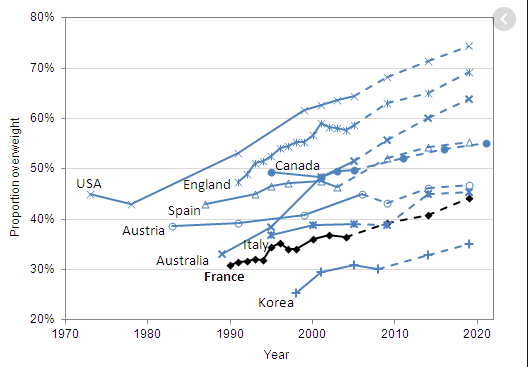The Food and Agriculture Organization of the United Nations (FAO) provides “Food Disappearance” data that lets us see how much food any given nation uses per person per year. This is not an exact dietary record because of course we have no idea how much is wasted. It also doesn’t count home produced foods that don’t show up in commerce. With those caveats, it is a very useful resource that definitely gives a pretty good snapshot of what is eaten in a country.

In previous posts I have defined the French Diet as being a diet where the staples are starch and dairy fat. A significant amount of meat is also typically eaten. I have frequently referenced 1970 as the year of the ideal French Diet in France proper. This is because by 1970 France had had a full generation to recover from WWII but Ancel Keys nutritional “wisdom” hadn’t taken hold yet. So what were they eating then and how did their diet change over the next 30 years? By 2000 it was clear that obesity rates in France were rising.
| 1970 Usage (Calories/day) | 2000 Usage (Calories/day) | |
| Wheat Flour | 721 | 718 |
| Sugar | 387 | 375 |
| Potatoes | 177 | 121 |
| Alcoholic Beverages | 297 | 165 |
| Butter | 177 | 174 |
| Other Dairy Products | 356 | 384 |
| Meat | 488 | 548 |
| Modestly Unsaturated Oils – Olive/Peanut/Canola | 110 | 133 |
| Very Unsaturated Oils – Corn/Soybean/Sunflower | 69 | 213 |
It is actually remarkable how similar the French diet was in 2000 compared to 1970. Over thirty years they cut back on alcohol and potatoes and replaced those calories with a little meat and cheese. In fact the ONLY major dietary change in France in that time was a marked increase in sunflower oil, a highly unsaturated fat (there are high oleic sunflower oils on the market now but regular sunflower oil is 60% polyunsaturated). And what happened?

By 2000, The French were likely getting around 6% of calories from added polyunsaturated fats. The French would have already had 1-2% of calories as polyunsaturated from sources such as pork fat, poultry fat and dairy fat. By 2000, they would have been eating 7-8% of their calories as polyunsaturated fat, the same amount that fattened up the mice.
